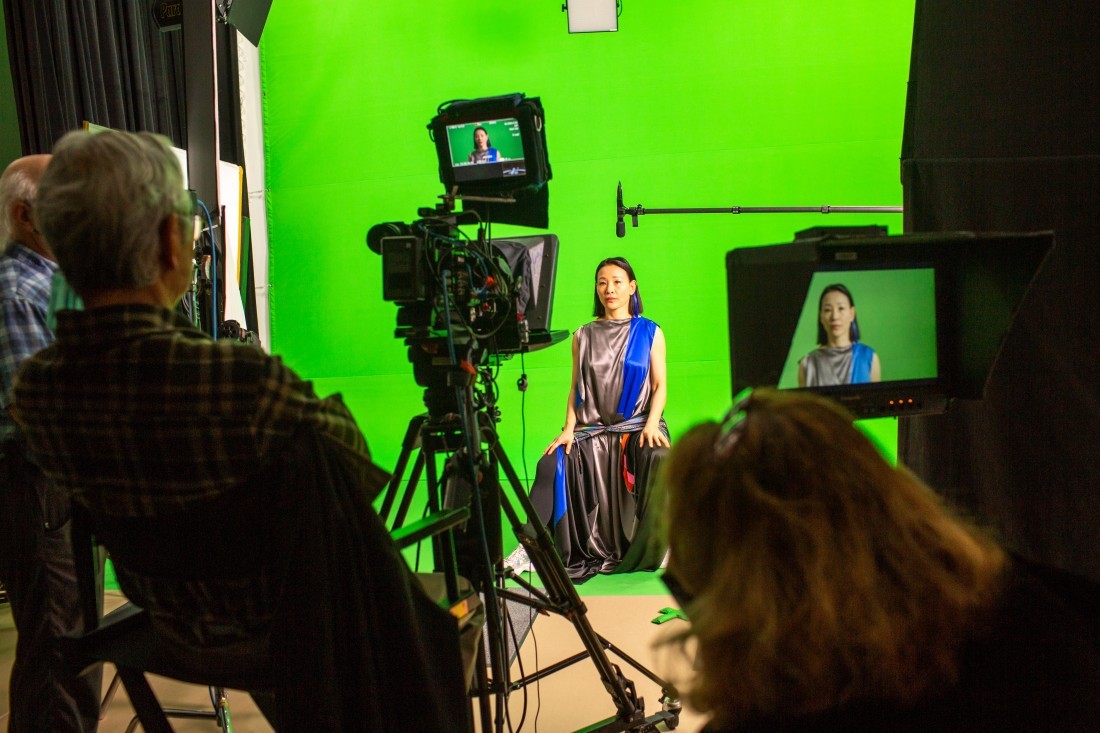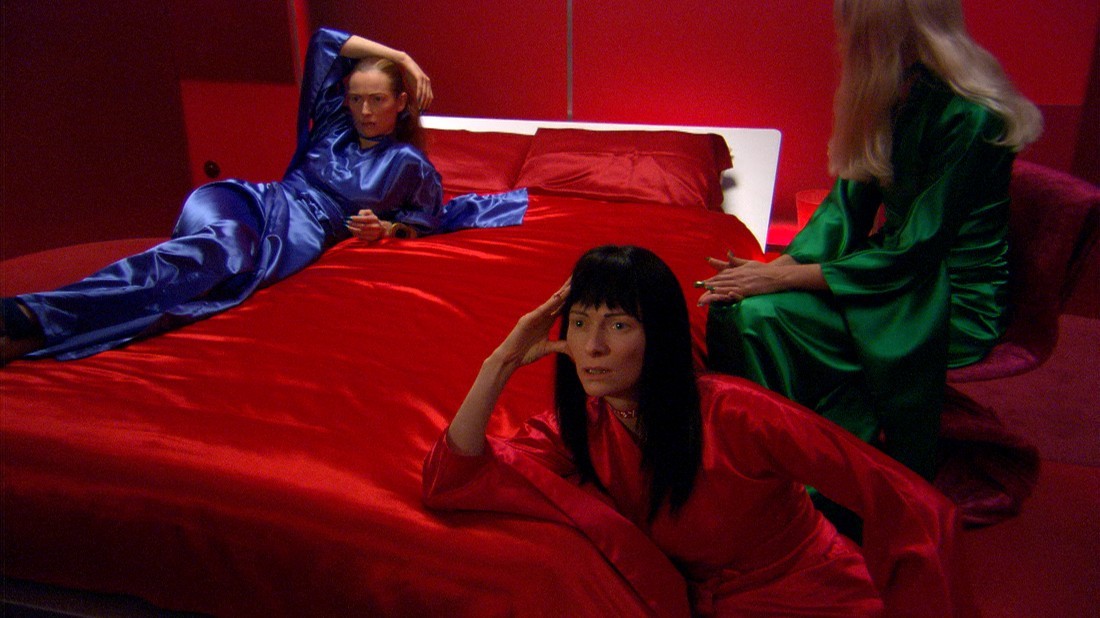Found Everything
An Interview with Lynn Hershman Leeson
In her life so far, the San Francisco-based artist Lynn Hershman Leeson has lived the lives of many women. If, in addition to making films, a film were to be made about her, it could take a clue from the 1957 drama The Three Faces of Eve. But to be accurate, the film would have to increase the number in its naming. Her biopic would be called The Multiple Faces of Lynn, and what it might lack in drama it would more than compensate for in intelligence and technological innovation. Hershman Leeson’s practice as an artist has been going on now for 55 years, and over that time, she has continued to make compelling and groundbreaking work. In The Dante Hotel, 1972–73, she set up one of the first site-specific, interactive environments in a rundown San Francisco hotel; in Lorna, 1984, she constructed an installation that used the first interactive video disc; in Teknolust, 2002, she employed state-of-the art high-definition video and graphics to make a feature-length film about love in the age of artificial intelligence; and in The Infinity Engine, 2014, she designed a functional replica of a genetics lab, which included among its specimens genetically modified fish and animals. As early as 1970, she was making table settings and hosting performance dinners before Judy Chicago’s first exhibition of The Dinner Party in 1979. Hershman Leeson has always been ahead of her time.
One of the critical components of that positioning has been her ability to invent characters through which she could be herself by being others. Self-Portrait as Another Person is the title of a sculpture made in 1965, but it could as easily be a description of her overall production; she is perennially making self-portraits in the guise of other people. In Conceiving Ada, 1997, a brilliant DNA researcher named Emmy Coer has become obsessed with Ada Byron Lovelace, a mathematician credited with inventing the first computer program in 1843. “I even dream about her,” she tells her soon-to-beformer partner, “I can’t seem to separate our lives.”

Lynn Hershman Leeson, Logic Paralyzes the Heart, film still, 2021. Photo: Pamela Gentile.
The generative confusion that afflicts Emmy is Lynn’s as well. The most complex of her adopted characters was Roberta Breitmore, a fictional alter ego she created in 1973 and then performed for the next five years. She called Roberta “my own flipped effigy—we were living encrypted lives.” Miss Breitmore managed to secure a driver’s licence and credit cards and to place a classified ad for a roommate, and had her own wardrobe, speech patterns, gestures and mannerisms. By 1977 she had divided into four personalities, all of whom were performing in public as Roberta. For Hershman Leeson, living two lives became so complicated that she felt the need for an exorcism, which occurred in 1978 in a ceremony at the Palazzo dei Diamanti in Ferrara, Italy, over the crypt of Lucrezia Borgia. For the most part, Roberta was gone, or at least one of her manifestations stopped turning up. But she came back on numerous occasions: in 1978 as the heroine of a graphic novel drawn by Zap Comix artist Spain Rodriguez; in the form of a telerobotic doll in 1996; and as a Second Life avatar in Life Squared in 2005. It seems that once you’re someone else, it becomes increasingly difficult to be only yourself.
There was something appropriate about Roberta’s address when she first arrived in San Francisco. She registered at the Dante Hotel, a fabulous name that recalls the Hotel California, another infamous West Coast establishment. In the lyrics of the Eagles song, it’s a hotel where “you can check out any time, but you can never leave.” As a persona, Roberta was like that; Lynn might have thought she had checked out, but it must have seemed as if she was never going to get her to leave.
Roberta and the other women whom Hershman Leeson invented traced a rich and layered psychological profile. Any persona is a mask, and any mask performs a double function: it is a way of assuming one identity while hiding another. In a 1993 text called “Romancing the Anti-body: Lust and Longing in (Cyber)space,” Lynn underlines the need for a personal mask. “Masks camouflage the body and in doing so liberate and give voice to virtual selves. As personal truth is released, the fragile and tenuous face of vulnerability is protected.” Hershman Leeson has admitted to a number of traumatic periods and events in her life, and in response her adoption of other selves functions as a strategy of disengagement. Her most revelatory project in this regard was The Electronic Diaries, 1984–2019, an extended series of video recordings where she speaks to the camera as if it were a cross between an intimate companion and a therapist. She describes the diaries in a straightforward way—“I began to reconstruct myself by talking into a video camera”—but what she records is disarmingly direct and devastating. In a combination of association and stream-ofconsciousness, she relates incidents that include eating disorders, marriage breakdown, abandonment, domestic violence, physical and sexual abuse, incest, the Holocaust and horror. At one point in the Diaries she says, “We need to perform major surgery on our psyches.” These unrehearsed spoken diaries are that surgery, and as a viewer you can’t look away.
As a maker, though, Hershman Leeson uses technology as a screen. In the “Phantom Limb Series,” 1985–86, the apparatuses of technology become both a medium and a way of physically altering the body. The women in these photographs (the images were made before Photoshop) are mutations in which normal body parts are replaced by cameras and television screens, prosthetic devices that transform them from subjects into objects of technology. In the video Desire Inc., 1990, Hershman Leeson says that “mass communication is mask communication”; the shift of a single letter articulates an entire way of thinking about what technology enables and what it covers over. In her work, mask communication and mass communication are inseparable aspects of the same condition.
Hershman Leeson has said, “In everything I did, I invented provisional identities for myself. I was looking for a voice and I suppose an identity.” In that personal search she has found collaborators who have been on a similar quest. She is especially attracted to collaborations; they find expression in her ongoing film work with Tilda Swinton; in Conspiracy of Silence, 1991, a 16-minute-long video with Yvonne Rainer and Carolee Schneemann on Ana Mendieta’s final moments; and most effectively in her 83-minute-long documentary about the women artists and activists who were at the centre, and on the edges, of the Feminist Art Movement beginning in the ’60s and moving through the ’70s. !WAR / !Women Art Revolution, 2010, is an amazing tribute, a film so rich that it could be an entire series. Any one of, and all of, the 40 women mentioned or interviewed in the documentary warrant a film of their own, which Hershman Leeson acknowledged in turning over 12,428 minutes of footage to the Stanford University Libraries so that it can be put online and made openly available. Hershman Leeson makes the proper decision to include herself in the film because she was a significant part of the artistic and political history that she is documenting. In 1976 she was asked to create displays for 25 windows for the Bonwit Teller department store in New York. Her installation, which lasted only five days, incorporated video, film, photography, mirrors, holography, mannequins and live actors who conversed with passers-by through two-way microphones. In one of the windows, a mannequin’s hand crashes through the window, its fingers reaching for the outside air. The action is a metonymic embodiment: the hole in one project stands in for the whole of the work. Finding herself in an enclosed space, Lynn Hershman Leeson finds a way, at whatever cost, to break through any barrier that she comes across.
The following interview was done by phone to the artist’s San Francisco studio on October 29, 2021.

Lynn Hershman Leeson, Tilda Swinton as Ruby, Marinne and Olive in Teknolust, 2002, 24K HD, 35mm and 4K feature film written, directed, produced and edited by Lynn Hershman Leeson. Commissioned for ZDF TV. © Lynn Hershman Leeson. Courtesy the artist and Bridget Donahue, New York.

BORDER CROSSINGS: When we were setting up our interview, you mentioned you were starting a new film next week. I’m interested in knowing what it’s about.
LYNN HERSHMAN LEESON: It’s about a cyborg who realizes what has happened during her lifetime because the cyborg is now 61 years old. It was born in 1960 from NASA. It’s really about how all of those born to technology into warfare have infiltrated our lives, except that the enemies have changed from warfare to individuals in society.
Is this going to be a feature-length film?
No, this one is short. I was doing a feature-length project for a long time and I cancelled it two weeks ago. It got too complicated with all the producers wanting to change it and wanting to make it their film.
You’ve said that you don’t believe in boundaries, and the range of your films indicates that you’ve taken that as film gospel. You’ve run the gamut from conventional features to documentary, through television commercials to mockumentary. Do you easily cross over from one kind of filmmaking to another?
Yes. It depends on what the subject is. This one is going to be an installation. It’s called Logic Paralyzes the Heart because the Internet and logic from AI are all based on predictions and expectations rather than empathy. It’ll be just a small installation, a micro-film, similar to Shadow Stalker (2018–21). It’s the next one in that line.
In your storytelling does one narrative engender the next one?
The next thing does seem to come out of the birth of the previous one. It happens with my diaries, too. Also, you’re under time pressure when things are commissioned and you have to finish them by a certain date, so you don’t have the luxury of waiting a couple of years while you’re thinking of something. Lately I finish something and then I find out what I should have made and what I left out.
You even mix genres inside the same film. In Strange Culture (2007) there’s acted performance and there are documentary elements, and those are of two kinds—news footage and interviews with actual people. Is it always the story that dictates the form and the kind of information you’ll include?
Yes. Generally, I start with something outlined. Then, once I start making or editing, I realize there could be more in it. It’s not the kind of film where you make a script and you have to keep to the original plan. It’s always fluid. And you can break from the script. That’s one of the things that Tilda liked when we worked together. Sometimes we’d completely veer off the script.
…to continue reading the interview with Lynn Hershman Leeson, order a copy of Issue #158 here, or Subscribe today.

